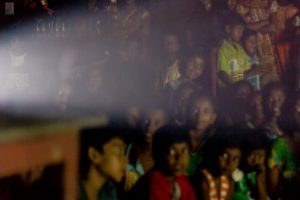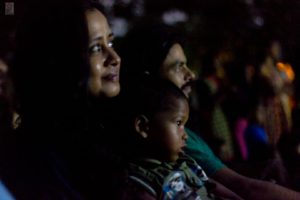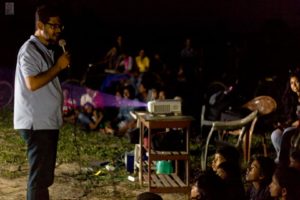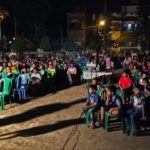Little Cinema comes back to Kaikala
Little Cinema, as part of its summer-long programme of travel took an assortment of films to Kaikala gram, Hooghly, a village situated a few stations from Singur. We had been invited by the local organisation Kaikala Chetana, which has been working on issues of alternative education in the area for more than twenty years now. The organisation has a reach of about six hundred children scattered over several villages in the area. Last year in April, Little Cinema had travelled to Kaikala for the first time on the invitation of the same organisation. On that occasion, the theatre group Swabhav Kolkata had also travelled with us in order to perform their play “Hath Ghoralei Golpo”, based on two animal fables. The programme had been immensely successful, as we gathered from conversations with the villagers in the later weeks – with children discussing the details of the play, singing its songs and remembering images from the films for weeks to come.

This year again, we took up the invitation from Kaikala Chetana and took some of our films to the village. We took the afternoon train to the village, where we had the good fortune of seeing the small school and travelling library that Kaikala Chetana ran in the place. There was also an open courtyard where children could play, walls on which they had painted, and a small garden with trees that children had decorated. We then travelled to the location where the screening was supposed to take place. Unlike the clearing in the middle of the village, where we had hoisted the screen last year, this one proved to be a more challenging location, technically speaking. More than a hundred children and around the same number of adults had gathered in an open field, where we pitched our screen on two bamboo poles. It was quite difficult to complete the set up, first because of the intense heat and then after sundown, owing to the speed of the wind. The laptop had heated up in the 42 degree sun all through the train journey and took a while to start up. The screen had to be weighed down with bricks. The sound box and board had been forgotten by the organizers, and they appeared later on a van rickshaw. There was the danger of some unpredictability with the electricity and we were worried about surge protectors that could guard the projector. Most of all, everyone was worried that there might be storm, in which case, given the speed of the Nor’wester, it would have been hard to protect the screen from being damaged. However, after some anxiety, the set up was completed and it seemed there would be no mishaps because of the weather.

The field had by now been laid with jute and tarpaulin sheets, and a crowd of about a hundred children had gathered. After one of the organizers from Kaikala Chetana introduced Little Cinema and explained what we do, Subhashish Goon took over on behalf of People’s Film Collective. The first film that was shown was from Brazil. It was called The Boy, the Slum and the Pan’s Lids and was of roughly 5 minutes duration. The film had the children in splits and they clapped along with the music that came at the end. The next film was Neighbours, of around the same duration, from Canada and this too made the children laugh a lot. The next two films were Satyajit Ray’s Two and Jafar Panahi’s Accordion. Most of these films were without dialogues, or had very little conversation. In the case of Panahi’s film, in spite of the fact that the children were neither able to understand the spoken language nor read the subtitles in English, they were able to explain the story perfectly in the discussion that followed.

On the way back on the train, we discuss amongst ourselves of the strange power of the language of cinema, since this is something we have noticed before during our programmes. Language was no barrier. It was the images that spoke. Next, played the music video Gaon Chodab Nahi, to which the children clapped and swayed, and even danced. When asked, they were able to tell us that the song was about protecting villages, forests and lands from the greedy hands of the ‘ingrej’ (‘angrez’/British colonial powers). True enough, we thought, when we consider the neocolonial operations of global capitalism and the force of ‘development’ that functions as its primary weapon. We made sure we simply listened to the children and did not correct them in anyway. There were discussions after every film. The last and longest film was Superman of Malegaon, which the children enjoyed in parts – even though it may have been too long to sustain their attention throughout. When we left, we distributed envelopes with letter papers and stamps so that the children could write/paint their responses to our programme and send them back to us. Over all, we feel it was a productive and enriching experience for Little Cinema, and we hope to be able to go back again.
Report: Trina Banerjee
Pictures: Kunal Chakraborty


